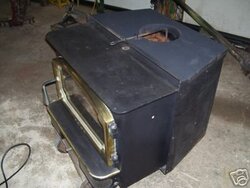Darren Clark said:
Thanks Gooserider. I really appreciate the super quick response. I've had others recommend extending the chimney, getting a windbreaker cap, etc. The thing is, in the winter when it is cold out, the stove works great.
This is fairly typical - just about ALL chimneys will draw better when the weather is cold. A chimney runs on heat differential, the greater the difference between the inside and outside temperatures, the better the chimney will draw, especially once you've gotten a fire going and a positive draft established - it tends to be a self perpetuating engine.
It only seems to be an issue when it warmed up and especially when the humidity was higher. Like today, when it's expected to hit 90 again! It is an exterior masonry chimney in decent shape. I had an installer suggest part of the problem is that the fireplace is in a room that is half underground (tri-level house), so it acts more like a basement chimney and will tend to draft poorly.
However you have what some folks refer to as an "evil chimney" - if you do a search on that term you will find lots of references... That it's an exterior chimney is bad, and a low level entry makes it even worse, as both factors tend to contribute to flow reversals. If you hold a flame or an incense stick by the stove's stack opening when it's being a stinker, I'm willing to bet that you'll find either no draft at all, or that there is an airflow down the chimney into the room. Essentially what you have to do is keep the flow from reversing. The best way to do this is to fix the basic design so that it works right - this is where putting in a full length insulated liner with a bottom blockoff plate will really help - by reducing the area the chimney has to flow the wrong way, it will be much less likely to do so. Eliminating alternative air exit paths by weathersealing the house better will also help (and will also make your future heating performance better.)
As a temporary "band-aid" approach, I've heard of some folks that have been able to keep a positive draft going by mechanical methods - A wind cap might work, but is probably the least likely to. Other approaches I've heard of include either putting a small fan (like a computer cooling box fan) blowing up the chimney, or burning a light bulb to warm the air inside the stove - some have even used those big glass "7-day" church candles - just something to keep the air at the bottom of the chimney warmer than the air at the top, so that it will draft properly.
I really had no trouble getting it to burn as long as it was below freezing. I tried stuffing some insulation down the chimney this spring to block the back flow...big mistake, it smelled even worse. I had a guy come over and do a halfa@#ed sweeping job(it was free, friend of the family,he used round brushes on a square chimney, you get the picture).
Definitely you need to do a better cleaning - friends are good cause the price is right, but you have to have the job done properly. It is something you can do yourself if you are reasonably handy with tools and don't mind some potential roof work (depending on your setup) - this is ESPECIALLY critical with a direct connect setup! One of the problems with a direct connect is that when the smoke goes from the stove pipe into the chimney, it tends to expand, cool, and slow down, depositing a lot of creosote at the connection point - this creosote tends to run down the chimney and build up between the outside of the connecting pipe and the chimney wall, where it stinks in the summer and poses a fire hazard in the winter. Modern stoves are better about this than old ones, but it can still be an issue.
The reason the insulation didn't work is because fiberglass insulation is porous - air goes right through it unless you do something like wrapping it in plastic to seal it.
I also have another problem, I need a trim hardware too. Seems like Bill and I have similar situations. Not the surrounds, but the kit to convert it to flushmount. My local dealer said Lopi never made it. This stove was sold as two different models, one that flush mounted and one that didn't. The new ones come with an optional conversion kit. The stoves look so similar, you'd think they'd be universal!
This is something that should be mentioned in your stove manual - I don't know the answer, but you should be able to download a copy of the manual from the Lopi website, and if they make a conversion kit for your model, it would be in the manual. Failing that, I'd try Lopi tech support. Note that if the stove isn't listed by the manufacturer to be used with a conversion kit, it is a definite code violation to try and convert it, and potentially a safety hazard. The manual is supposed to list every condition that the manufacturer had the stove tested and certified as safe to use - attempting to do things not in the manual is going into "no-man's land" where either no testing has been done, or the testing failed, so there is no easy way to tell if it is safe to do or not - since code has to be conservative, it won't allow it.
Gooserider


